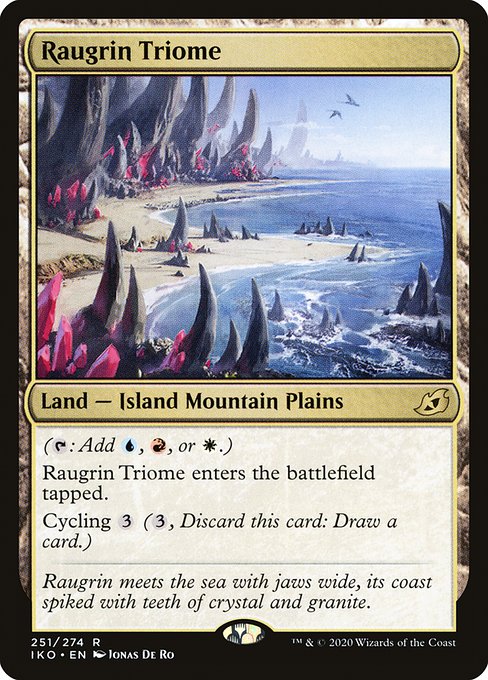
Image courtesy of Scryfall.com
Designing Raugrin Triome: A Story of Color, Coast, and Curiosity
In Ikoria: Lair of Behemoths, Wizards of the Coast stitched a bold narrative thread through its land slots: the Triomes. Raugrin Triome, a rare treasure from the Ikoria cycle, is more than a fixer; it’s a storytelling device that bridges three colors—red, blue, and white—within a single, cohesive land. Its very existence invites players to dream of a world where coastlines are not boundaries but gateways. 🧙♂️🔥💎
The artistry behind Raugrin Triome is a deliberate beat in a larger drumbeat: a tri-color ecosystem where different tribes, climates, and magical traditions converge. The card’s type line—Land — Island Mountain Plains—tells a compact story: Raugrin is not one thing, but a geography where water, fire, and order meet. The flavor text solidifies that mood: “Raugrin meets the sea with jaws wide, its coast spiked with teeth of crystal and granite.” It’s a vivid image of a place that can be calm and cataclysmic in the same moment. And that paradox—the coexistence of harmony and danger—forms the heart of the storytelling intent behind its effects. ⚔️🎨
Mechanics as Narrative: Three Colors, One Land
Raugrin Triome’s mana ability—“{T}: Add {U}, {R}, or {W}.”—is a quiet coup in storytelling terms. It embodies a coast that refuses to pick a single mood. The land literally chooses among blue for knowledge and control, red for impulsive energy, and white for order and protection. This tri-color flexibility mirrors a world where cultures collide, negotiate, and ultimately cooperate toward shared goals. The decision to have the land enter the battlefield tapped is not mere game balance; it’s a narrative choice. A coast cannot instantly unleash its resources on a sailor’s whim; it takes preparation, time, and space. The tap comes as a reminder that in a volatile region where three colors push in different directions, patience is part of the design narrative. 🧭
Adding a cycling option—“{3}, Discard this card: Draw a card.”—further deepens the storytelling. In a world of monsters and shifting alliances, Raugrin Triome is always ready to pivot. If the initial plan to deploy a favorable multicolor mana base stalls, the card becomes a retreat, a plan B that still honors the land’s three-way nature. It’s not just card advantage; it’s a metaphor for adaptation in a landscape where the sea, the cliffs, and the inland plains demand flexibility. The cycling cost is intentionally high enough to prevent abuse in the open, but approachable enough to reward patient deck construction. This is design balancing with a narrative eye. 🎲
Raugrin meets the sea with jaws wide, its coast spiked with teeth of crystal and granite.
Gameplay Implications Across Formats
In Commander and other multiplayer formats, Raugrin Triome shines as a reliable three-color fixer. Its presence accelerates mana bases that rely on three colors, enabling big, splashy plays a turn or two earlier than a more conservative land lineup would permit. In formats like Modern and Pioneer, the Triome’s ability to tap for {U}, {R}, or {W} makes it a staple for decks that want to avoid fetching too many times while still keeping a robust mana base. The fact that it enters the battlefield tapped imposes a tempo consideration, but the cycling option helps smooth out hands that would otherwise stall—an elegant trade-off that resonates with the Ikoria era’s theme of resilient, adaptable magic. 🧙♂️
- Strategic value in three-color decks: Raugrin Triome unlocks white-leaning control decks that still need red’s aggression or blue’s permission spells, creating a flexible platform for diverse lineups.
- Tempo vs. stability: Early turns may be slower due to the tap, but the long-game payoff is strong, especially when combined with cycling to find action or for card advantage.
- Format-agnostic appeal: In Eternal formats, the Triome family remains a sought-after cornerstone for mana bases, while in Limited, its rarity and color identity shine as a aspirational pick for three-color decks.
Flavor, Art, and the Designer’s Intent
Jonas De Ro’s illustration for Raugrin Triome captures a coastline that feels alive—crystal teeth along the shore, granite shoulders rising to meet a three-colored sky. The art communicates the card’s dual nature: beauty and danger, balance and risk. The trio of colors in the mana symbol mirrors the region’s tri-cultural tapestry: red’s volcanic energy, blue’s maritime cunning, and white’s order and resilience. In design terms, the art reinforces the mechanical narrative: a land that is generous enough to offer three paths, but tempered by the cost of entering tapped and the option to cycle for a new chance. This is storytelling through art and function working in harmony. 🎨
Ikoria as a set pushes players to think about evolution—how environments transform, mutate, and adapt. Raugrin Triome embodies that ethos at a micro level: a single card that embodies a region’s complexity and a culture’s adaptability. The flavor text anchors the lore, while the mechanics give players a tangible tool to sculpt their own stories at the table. It’s a coin with three sides—each flip revealing a different strategic speech, and every decision echoing the coast’s ancient, patient rhythm. 🔥
From Table Talk to Tabletop Promos
For fans who love to keep a physical reminder of their MTG journeys near their decks, cross-promotional gear can be a delight. If you’re balancing dice, sleeves, and a growing collection of triomes, a sturdy phone grip can help keep your play area tidy and your hand free for quick decisions. The product below is a lighthearted nudge to stay organized while you chase those tri-color combos across the table. 🎲
Image courtesy of Scryfall.com